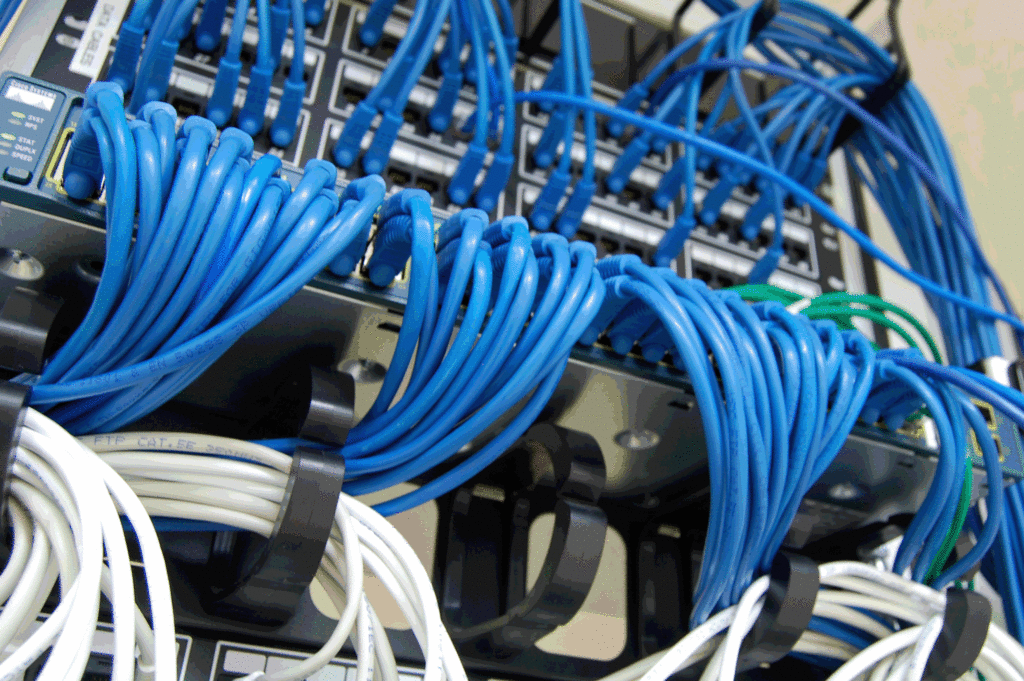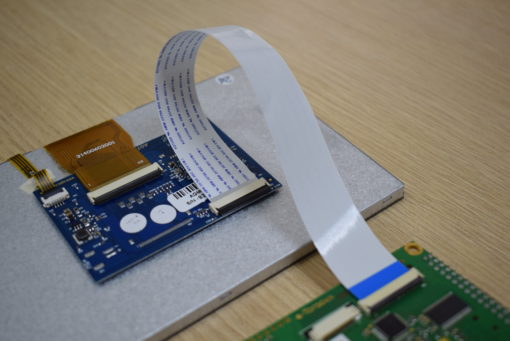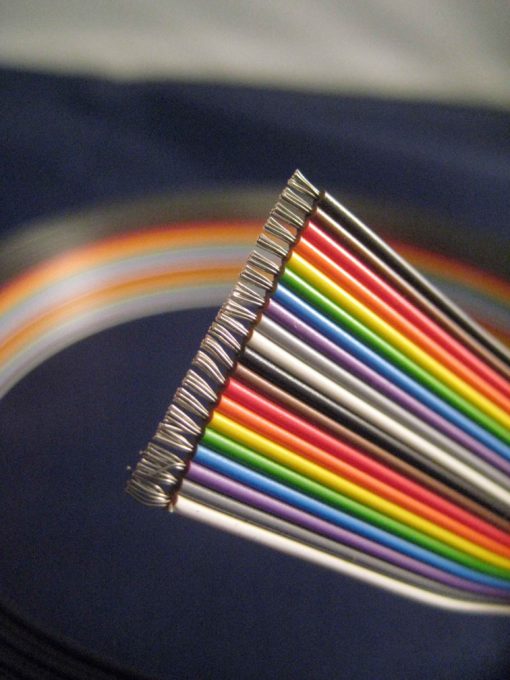
The flat profile of Flat Cables determines a smaller volume than the one taken up by round cables, when mutually overlapping or grouped, and the polymeric coating eliminates the need of specific ducts for cables.
Cables generally have a circular section and this geometry is the most suitable for most applications but there are also “flat” cables, flat and highly flexible that, available on the market for a long time, have been subjected to interesting innovations that can widen their application fields.
Preliminary assumption
The acronym FFC (Flexible Flat Cable) refers to any variety of electric cable that is both flat and flexible, even if in time the denomination of Ribbon Cables to indicate “multi-wire planar cables” has spread. These cables, characterized by multiple conductive wires of the same size and parallel one another on a flat and flexible plastic surface, are typically used to connect the drives of the internal peripherals of a computer, for instance hard disk and CD, even if in some old computers, such as the Apple II series, Ribbon Cables were used also for external connections. These cables were implemented for the first time in 1956 for IBM by the California company Cicoil, which also gave them the name “ribbon” because of their similarity with the typewriter ribbon of that age. Afterwards, several other companies, and it is worth mentioning in particular 3M, started a massive production of these cables, with the standardization of spacing, thickness and insulation of conductors: the user-friendliness of cables, the low alternative profile to conventional cables and the low costs deriving from the standardization of manufacturing processes have made them the ideal choice for PC, printers and manifold electronic devices. The connection provides for a particular connector called IDC (Insulation-Displacement Connector) with which the cable is forced into a row of contacts; connectors can be present at the two extremities or at a single termination, as it happens when the ribbon is welded to a device or to a peripheral on one side. Speaking of colours, it is worth reminding that to reduce the connection inversion risk, one side of the cable has red colour but, since in some applications it is necessary to identify groups of conductors, or even single elements, manufacturers have introduced a “rainbow ribbon cable” with a pattern of colours derived from resistors’ colour code, and so a bizarre denomination, “hippie cable”, started diffusing. Considering the strictly technical aspects, a Ribbon Cable is characterized by two parameters, indicating with “pitch” the spacing among conductors and with “ways” their number, which can range from 4 up to 80. More in detail, the pitch refers to the distance between the centre of a conductor and the centre of the one immediately close and parallel to it: usual values are 0.500 mm, 0.625 mm, 0.635 mm, 0.800 mm, 1.00 mm, 1.25 mm, 1.27 mm, 2.00 mm, 2.54 mm. Criticalities are not missing: if from the digital point of view a Ribbon Cable is ideal to connect two devices, from the analogue point of view some interferences can arouse, to the extent that in the early Eighties the American Federal Communications Commission discovered that these cables can operate from antenna, diffusing random signals in a very broad band of the electromagnetic spectrum, hence the recommendation of using Ribbon Cables only inside equipment and of prearranging a grounding in case of external connection between two systems.

The user-friendliness of cables, the low alternative profile to conventional cables and the low costs deriving from the standardization of manufacturing processes have made them the ideal choice for PC, printers and manifold electronic devices
Round versus Flat Cables, the differences
In the implementation of an electronic system, cables are almost always the last component that is specified by the engineer, forgetting the importance of the wiring in granting a reliable and durable operation of equipment, especially if we refer to the preservation in time of the indispensable integrity of signals, both data and controls, which cables must convey. Today this is truer than ever, due to the conceptual formalizations of Industry 4.0 as irremissible reference for the organization of the Smart Factories of the future. In the choice of a type of cable, beyond the typical characteristics, for instance CEI regulations to which it conforms, the insulating material and sheaths, the quality of components, it would be advisable to consider in the early phases whether for a given application it is better a cable with circular section or, better, a round shape cable, essentially a standard in industrial applications, or a flat cable, even if considered a niche product until now. As conceptual basis, with the denomination of electric cable, we mean a uniformly insulated conductor or a whole of more conductors, each of them insulated from the others and the outside, and grouped in a single entity provided with protective coating. A cable includes more parts, starting from its metal part, then copper or other conductor, intended for conducting current, consisting of a single wire or more intertwined wires. The conductor is surrounded by a layer of insulating material, a mixture of materials opportunely chosen, dosed and subjected to various thermal and technological treatments according to the application context the cable is intended for. The whole of the conductor and of the relative insulation constitutes what is generally called the cable core; more cores can be present and the outer casing applied on the whole of cores is the sheath, which can be reinforced by metal elements. Finally, cables can be also provided with a coating acting as a mechanical or chemical protection. The structure of a cable exerts a direct impact on its performances, considering that on the field cables undergo more types of torsions and bends, repeatedly and even simultaneously, in literature identified with the denominations rolling flex, bending flex or “tic-toc” (metronome-type), torsional flex and variable/random motion flex. Round cables can withstand all these stresses due to their possibility of moving on multiple axes at the same time and, for instance, in certain applications they can bear even 30 million flexes before needing replacement while flat cables are suitable for the rolling flex, since this motion occurs on a linear axis. Concerning electromagnetic interferences (EMI), while optimal solutions are enabled by different shielding types for round cables, it is more difficult to achieve the same result with flat cables. We could deduce from these short notes that flat cables unavoidably remain confined in niche, or anyway specific, applications but some innovations are not missing.

In time, manufacturers have introduced a “rainbow ribbon cable” with a pattern of colours derived from resistors’ colour code, hence the bizarre denomination, “hippie cable”.
Evolution of Flat Cables
Ribbon Cables, and we use this denomination to indicate the current state-of-the-art of this category of cables, even if successful and widely diffused, in addition to the limiting factors above mentioned, are also affected by the one deriving from the type of termination technique, which requires manual work. To exploit all the advantages of flat cables, approaching also new applicative contexts, the company that 60 years ago had invented Ribbon Cables, has developed a new typology – with which it is possible to use the tools and the automated processes generally adopted for round cables – and the denomination Flat Cables is more suitable for it, because of a sort of generational differentiation. The market target is to make Flat Cables represent an alternative for applications in which round cables are the natural choice, obviously not for all but many of those that were previously unfeasible and, to succeed in it, new undoubtedly interesting characteristics are enhanced. Therefore, it is important to evaluate this new trend that, under certain respects, changes the rules of the game and the evaluation criteria of cabling alternatives. As previously illustrated in detail, round cables provide for multiple layers that surround conductors. These layers, which from a certain point of view can also be considered as essential elements to maintain the round profile of the cable and as protection from the outer environment, if differently interpreted they represent a negative factor, making for instance the heat dissipation more difficult, especially the one by friction generated when the cable is subjected to motions imposed by the application where it is used. Other negative aspect might be the electric impedance alteration when the conductors inside the cable move relatively one another. Starting from these potential criticalities, we underline that in Flat Cables each conductor is insulated from the others, hence the stability guarantee, without needing additional elements to mitigate friction effects, with consequent advantage of reducing weight and volume. Such characteristics result in the highest efficiency of a packaging that, offering a broad surface area for the heat dissipation, allows the passage of higher currents for the conductors of a given section. Definitively, the signal/noise purity is acknowledged to Flat Cables, with the addition of efficiency related to flexibility, heat dissipation, weight and volume: the defects of round cables, essentially ascribable to their geometry, state the supporters of Flat Cables, have been “tolerated” until now, or anyway managed with various structural solutions, due to both their extensive use but also especially due to the availability of tools that, unlike the case of flat cables, allow user-friendly termination and assembling. Today, however, it is available a new generation of Flat Cables that integrates the advantages of this cable typology with a better user-friendliness. Actually, it is worth reminding that the new Flat Cables have nothing in common with the first Ribbon Cables of the Sixties, which for instance used a single wire gauge for all conductors (28 AWG), which limited their use, whereas now we can range from 4 to 44 AWG (with the 44 size we refer to Flat Cables for micro-machinery and for other miniaturized electronic applications). Specifically, we remind that AWG means “American Wire Gauge”, standardized measuring system of the wire section, used since the half of the nineteenth century: the section of a wire (gauge) is on the other hand important to determine the maximum possible current intensity and then the possible applications. According to the standard, the increase of the AWG number corresponds to a progressively smaller wire diameter so that, for instance, a 30 AWG wire is very small whereas a 4 AWG is very big. Tables are for single, solid and round-section conductors, with AWG that is determined by the total area of the conductor section, which in its turn determines both the transport capacity of the electric current and the electrresistance.

Among the several applications of Ribbon Cables, also the connection among mobile devices of common use
Innovation comes from a new manufacturing process
Currently there is only one manufacturing company of the new typology of Flat Cables described, with its own patented process, Cicoil, which had also invented Ribbon Cables, therefore the details proposed here are unavoidably referred to this company, without any promotional purpose. The base is represented by a polymeric material with exclusive coating, a particular engineered rubber called Flexx-Sil, which grants outstanding flexibility as well as resistance to extreme temperatures, from –65°C to 260°C, to water, wetness and chemical agents. The extrusion process with which are implemented Flat Cables of continuous length, allows combining single different conductors in a single flat cable, including also shielded cables, tubes for pneumatic applications, Ethernet Cat. 5e cables, optical fibres and coaxial cables, thus supplying a solution aimed at saving space and at reducing the wiring complexity. Ideally, the process can be schematized like a box where on one face (conductor in) the various conductors enter, separated one another, on the opposite face (cable out), conductors exit, assembled and parallel one another, in a planar Flex-Sil Jacket, with, on the box side, the input of the technological functions characterizing the extrusion process, as well as the polymeric raw material. Each conductor can then be divided from the cable body, extracting its terminal part for the termination and connectivization operations that at this stage, depending on the type of conductor, are the same involved by round cables. The flat profile of this solution determines an inferior volume than the one taken up by round cables when they are overlapping or grouped, and the presence of the polymeric coating eliminates the need for special ducts for cables, minimizing space and weight. This “ready to use” solution provides a new paradigm in the implementation of custom Flat Cables, with the possibility of a different wiring that can be really an alternative to the use of traditional round cables in several situations.
Redaction: Aldo Cavalcoli



